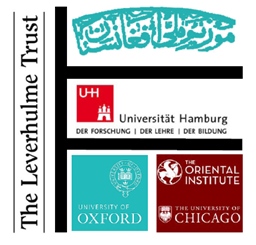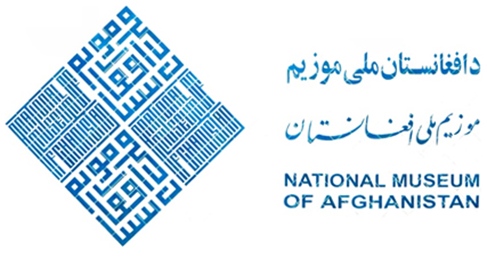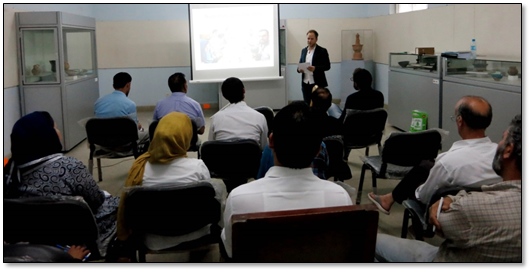BACH Staff Training at Kabul Museum 2015
BACH - Workshop and Trainee Program at the National Museum of Afghanistan in Kabul
July 25 to August 4, 2015
Report by Matthias Naue

The Project
The 'Balkh Art and Cultural Heritage' Project (BACH) situated at the University of Oxford, and headed by Edmund Herzig, offered a numismatic workshop for members of the museum, held by Matthias Naue, Universität Hamburg, in cooperation with the Oriental Institute (OI) of the University of Chicago, field director Michael Fisher, the National Museum of Afghanistan and the Asien Afrika Institut (AAI) of Universität Hamburg, Stefan Heidemann.
The workshop's goal was to offer staff members of the National Museum aspects of object documentation and coin attribution. During the ten days of the workshop the program included identification of Islamic coins, introduction of numismatic key literature, and practice in standardized documentation of numismatic objects. Current practises and possibilities about registering of the coin collection in a database of the Museum and their physical storage at were discussed and re-considered.
This workshop was the third instalment of research and numismatic training programs in Kabul by the Asien-Afrika-Institut of Hamburg University within the frame BACH project, after a 10-days workshop given by Stefan Heidemann in 2012, and a follow up three week on-the-job-training in September 2013 in numismatic object conservation and documentation by Stefan Heidemann and Matthias Naue.

National Museum of Afghanistan
In June 2015, about 6,000 coins - pre-Islamic and Islamic - were housed in the Museum's store rooms. In sheer numbers, these are one of the largest groups of items in the museum, taking up a lot of storage space, and curatorial attention. Some 2,500 were already registered in the database provided by the Oriental Institute, but the labelling was very generic such as "unknown Islamic coin" or "Abbasid coin 7th to 16th century" and unsuitable for practical and scholarly use. The expected arrival of even larger quantities of new coins either by excavations such as Mes Aynak or police confiscations from the illegal trade made a workshop how to deal with the coins in scholarly and yet in an efficient way with limited resources imminent.
The Numismatic Workshop
The workshop focussed on the practical work with numismatic items within a museum context and imbedded in it chapters of the scholarly side of numismatics. While introducing new literature and teaching the ways how to decipher coins, numismatic aspects were cast into guidelines of coin identification with the purpose of improving the database of the museum's inventory. Four staff members and one member of the team of the Oriental Institute regularly attended the workshop and some other colleagues joined in from time to time.

Discussion with Afghan colleagues - Matthias Naue at the final meeting of the workshop
Matthias Naue presented two lectures for the general audience of curators and conservators in an attempt to integrate the numismatic workshop into a wider perspective of the Museum.
Improving the library
While numismatic literature is essential for the attribution of coins and their dating, few numismatic works had entered the library of the National Museum. To remedy this situation, the BACH project provided about two dozen some standard references for the numismatics department at the National Museum of Afghanistan in Kabul and for the curators in charge. These works are essential for the attribution of coins. They provide the future bases of registration and research.
Improving the work flow
The Workshop developed a routine and set of rules to handle numismatic items to improve the workflow of the museum. Random unregistered coins were handed to the participants, and classified and identified, learning how to work with the new literature practically. Finally the results were entered into the data base. This situation closely resembles the way coins enter the museum. Within the two weeks, approximately 200 coins from different mints and periods of the Islamic era in Afghanistan were processed.
Improving the storage capacities
New ways of storage and object conservation of coins were introduced; ways which are different from object conservation of single items groomed for show cases. For example, standard practice was until now - in line with the guidelines of many other museums - that coins are treated as unique fragile objects: 6 to 9 coins were placed in carefully cut foam trays, packed in a box of 15 by 15 centimetres with only their inventory tag attached on a strip of glue. That not only occupies valuable rare storage space (especially in emergency situations), but the adhesive which will fade after some years in the dry climate of Kabul, leaving a necessarily confusion about the inventory numbers in the case. The BACH project recommended either special coin containers for the systematic collection with segmented trays (for example 'BeBa' coin boxes); or for the excavated coins, which are now present in the museum's collection, and expected torrent of excavation coming from

Storing of coins - labelled envelopes (left) for keeping the information with the coins and allowing more coins to be stored in the same space than in cut foam trays (right).
Mes Aynak and other places, simple acid-free standard paper envelopes, allowing the notation of the inventory number, technical data and if possible also an attribution. For the immediate implementation, the BACH team sponsored 3,000 of such envelopes (see illustration).
Conclusive meeting
At the end of the workshops the four regular participants explained in short presentations the main themes of the workshops and some results in Dari and making their knowledge accessible to the entire museum staff.
